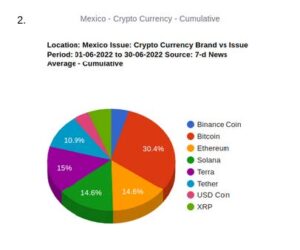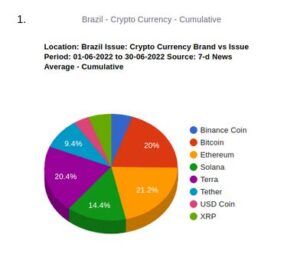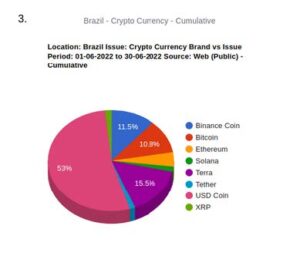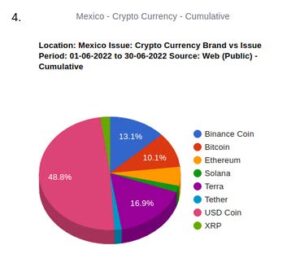Accumulative Analysis Shows Different Story for Brazilian and Mexican Web Users and Media Coverage of Crypto During July
- LatAm Intersect PR publishes latest monthly Emotional Climate Report (ECR) for Latin America
- ECR technology applied to public and press emotions around the issue of cryptocurrency brands across the countries of Brazil and Mexico
The month of July saw continued chatter about the future role of cryptocurrencies amid a further drop in the value of the two major coins: Bitcoin and Ethereum. Many investors worldwide are now preparing for a bear market of indeterminate length, with some saying the decline in value of the major coins could last months or even years.
However, the future for cryptocurrencies is still one that many investors see as much brighter than the present and even the past, likening this year’s ‘crypto crash’ to the dot com bubble, which ultimately gave rise to the much more efficient and lucrative tech market that we know today.
Our latest Emotional Climate Report (ECR) published by PR firm LatAm Intersect PR in partnership with empathy optimization specialists, Delta Analytics BV, shows how the media and the public in the two largest crypto markets in Latin America – Brazil and Mexico – have been preoccupied with distinctly different areas of the market.
What our research shows is that the media in both countries tend to focus on the big ‘brand names’ such as Bitcoin and Ethereum, while the web-using public have instead been focussed on the ‘stablecoins’ that allow them to use cryptocurrency as an inflation hedge and investment tool.
When comparing the cumulative 7-day media average for coverage of all the major cryptocurrency brands in the month of June, a remarkably similar picture appears in both the Brazilian and Mexican media.
Although the Mexican media has around 2,000 more data points than the Brazilian media (7,730 vs 5,904 to be precise) both countries’ media tended to mention the two major ‘brands’ of cryptocurrency – Bitcoin and Ethereum – much more than the popular ‘stablecoins’ (any cryptocurrency designed to have a relatively stable price, typically through being pegged to a currency) such as Binance Coin, XRP, Tether or USD Coin.
Bitcoin scored most mentions among the Mexican media, with almost a third (30.4%) (figure 2.) of all mentions in the media being related to the cryptocurrency with the largest market cap. In the Brazilian media, mentions were more evenly split between Bitcoin (20%) and Ethereum (21.2%) (figure 1.).
However, it also must be noted that two of the brands most closely linked to the year’s ongoing crypto crisis – Solana and Terra – still got a lot of attention from the media in both Brazil and Mexico, with Terra scoring particularly highly among the Brazilian media (20.4% of all mentions, slightly higher than Bitcoin) (figure 1.) and among the Mexican media (15% of all mentions, the second highest score after Bitcoin) (figure 2.)
When looking at the cumulative mentions of cryptocurrency brands among Brazilian and Mexican web users for the month of June, another startlingly similar picture also emerges. Both countries registered a similar amount of data points, with Brazilian web users registering almost 11 billion data points for the month of June, while Mexican web users registered just over 10.5 billion data points. The brand mentions for users of both countries also followed a similar pattern.
USD Coin scored the most mentions in both countries by a huge margin, with just over half (53%) of all mentions in Brazil being connected to the US Dollar-pegged stablecoin (figure 3.) and just under half (48.8%) of all mentions in Mexico being connected to the same brand (figure 4.).
This is followed by smaller but significant mentions of both Binance Coin and Terra – two other stablecoins – in both countries, with Bitcoin only scoring 10.8% of Brazilian mentions (figure 3.) and 10.1% of Mexican mentions (figure 4.) respectively.
So what could all this mean? One interpretation is that the media are much more fixated on the big brand names of the bitcoin market, such as Bitcoin and Ethereum, because these are easily recognizable, almost click-bait, to a wider audience of both investors, the crypto curious, and even those crypto skeptics who are perhaps enjoying some schadenfreude while reading about the current crypto crisis.
Among actual web users, however, people are much more likely to to actually engage with the so called ‘stablecoins’ which are more often used by investors to change down their
investments in value coins or simply as a safeguard against common economic problems in Latin American countries such as currency swings and inflation.
“What we’ve observed is that there is a big divide between public perception of cryptocurrencies in Latin America and how the media choose to report on crypto-related stories,” comments Roger Darashah, Co-founder of LatAm Intersect PR. “While the papers and websites love to sensationalize cryptocurrencies as a sort of Wild West of investments, Latin America is seeing a huge rise in what’s been dubbed the ‘crypto generation.’”
He continues, “With a growing trend in governments legislating to allow employees to be paid part of their salary in cryptocurrencies or even to pay taxes using these digital stores of value, more and more ordinary people in Latin America are choosing to invest part of their money in cryptocurrencies, not as some crazy ‘get rich quick’ scheme that the media would like to have us believe, but as a sensible hedge against currency instability that has historically dogged large Latin American economies such as Brazil, Mexico, Chile and Argentina.”
Roger adds, “Of course the bear market is concerning investors, especially larger institutional investors such as hedge funds and banks, but as long as inflation continues to push prices up and currency values down, we believe the ‘crypto generation’ will continue to make use of digital stores of value, just not the ones you’re used to seeing mentioned in all the headlines.”
LatAm Intersect PR will be publishing monthly Emotional Climate Reports on key issues of interest to the region such as: vaccines, economics, politics, crypto-currencies, the environment, diversity and equality.
“The technology reflects the basis of our agency, our audience-based programming methodology, and why we created them. Society’s number one favorite subject is itself; individuals are the new protagonists. The sooner and better brands understand what and how the public thinks, the deeper they’ll be able to engage,” he concludes.
Emotional Climate Reports are currently available in Argentina (Spanish), Brazil (Portuguese), Chile (Spanish), and Mexico (Spanish); versions for Colombia (Spanish) and Peru (Spanish) will follow.








